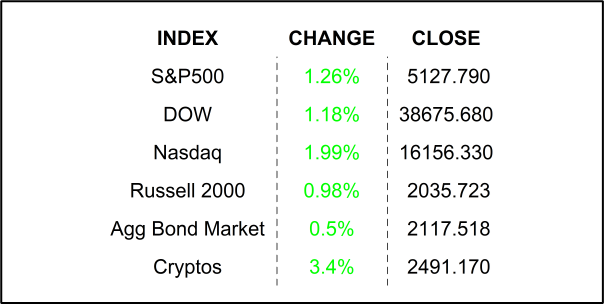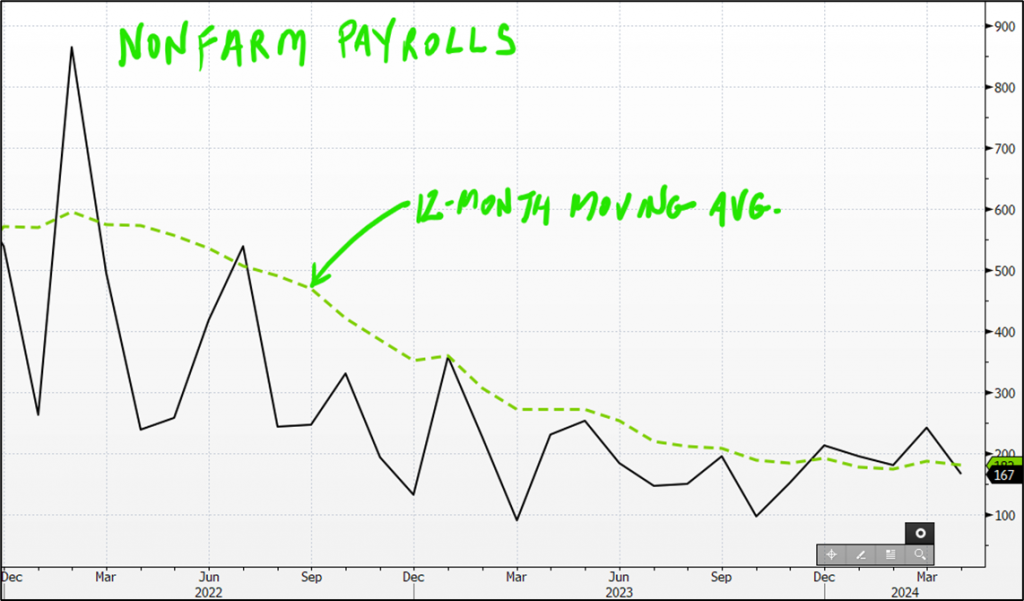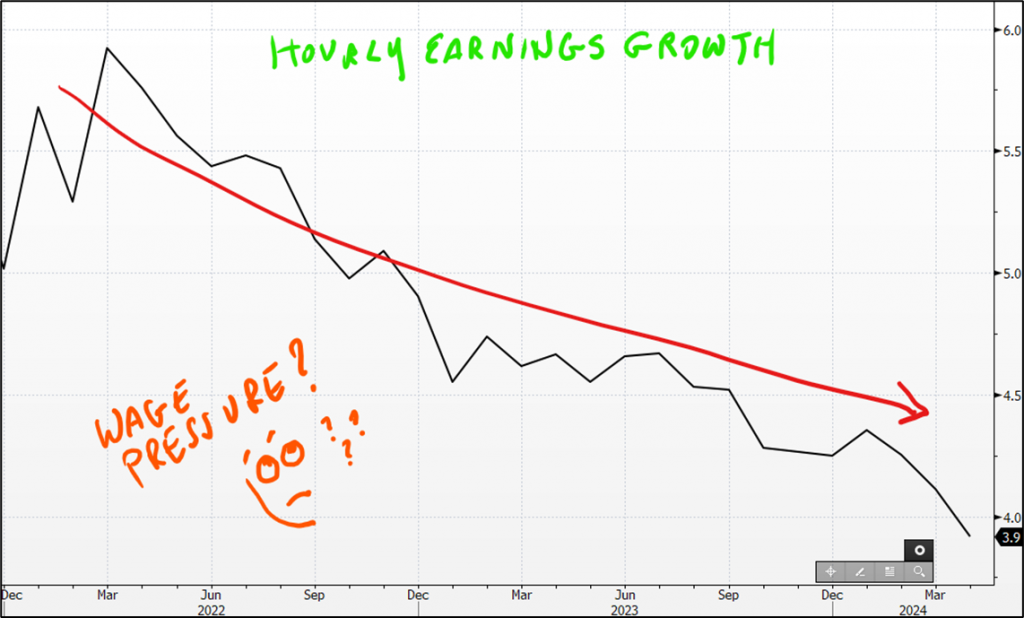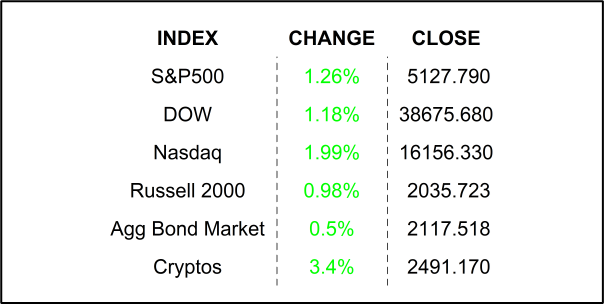
Stocks jumped on Friday after a cool monthly jobs number came in lower than expected. Apple’s surprisingly good quarterly earnings report deejayed for the fun filled dance party.
Cool breeze. Imagine how simple life would be if you only had 2 responsibilities. Only 2. Nothing else. You sit in a comfy chair, and you only need to focus on 2 things. Ahhh, if life were only that simple. Well, it IS that simple for the Federal Reserve’s Open Market Committee. It’s true they only have to worry about keeping inflation low and keeping the labor market healthy. That’s right, that is the Fed’s so-called dual mandate. To be clear, there is nothing in that mandate that says inflation should be at +2%, no, the bankers must simply keep inflation in check. And on the employment front, a healthy labor force is not clearly defined either. One can only imagine that it would mean lots of jobs for all and no mass layoffs.
Do you remember 2020? I don’t. At least I try not to. I should clarify that. I very much do remember the markets and economy but try to suppress all the horrible loss of life and crazy binge buying of toilet paper, cleaning products… well, pretty much everything, including extension power chords. Do you remember the mass layoffs that followed the lockdowns? That falls under mandate number 2 of the Fed. It jumped in and pulled the plug, lowering rates to 0% and opened a cash factory for all that were interested. I will give it to those folks, without them, those Fed Bankers, the economy would surely have imploded. But it didn’t, thanks to the Fed’s good work. Turn the clock forward to 2021 and the economy clawed its way back and better treatment protocols allowed us to emerge from our lockdown shelters and return to semi-normal life. This required all those businesses that shuttered to re-hire workers. There was a problem, however. Many workers were not eager to get back to work. Homelife was easy and the government was paying cash-money to keep people afloat.
This was a problem for companies who needed to bring their businesses back online as quickly as possible. What would you do if you were struggling to fill positions with customers lining up at your doors? Of course, OFFER HIGHER WAGES to get those workers out of their reclining chairs and back to the plow. That is an iron-clad strategy, but there is a downside to paying higher wages. That’s right, lower profit margins for businesses. Now, you can’t expect those rational companies to accept lower margins. No way, companies would raise their prices to not only maintain old margins, but even to increase them. Because, why not. And why not go to the economics playbook’s winningest strategy: “discriminate if you can.” Folks, that is what happened, and it did play a big role in what would become a +9% inflation rate by 2022.
Well, many folks did eventually return to work, quite happy with higher wages and possibly even some additional savings from government stimulus money. The employment rate dropped back down to multi-decade lows and cash-rich consumers were eager to spend their newfound wealth on everything… everything, giving businesses a free pass to raise prices even more. Inflation, inflation, and more inflation. By late 2021 the Fed had had enough, and it was time for them to get busy with mandate number 1, keeping inflation in check. So started the rate-hiking regime in an effort to slow the economy by throwing ice water on the labor market. If you don’t have a job or you are worried you could lose your job, you will demand less goods and services and hopefully, lower inflation.
So, what the heck happened and why the heck are we still talking about all this stuff in 2024? Well, inflation is lower by 2/3, but it’s not quite at the Fed’s self-set +2% target. And, according to the popular media, the labor market is still so strong. I have a question for you… actually, 2 questions. Is the labor market strong and are wages out of control? Last Friday’s Non-Farm Payrolls number came in lower than expected opening some eyes leaving us all asking ourselves these same questions. I am going to show you 2 charts. Check them out and follow me to a quick close… if you want to know the answers to those questions.


Ok, now pay attention. The first chart shows the Non-Farm Payrolls, which is new hires per month. You can see by the black line that it bounces all over the place, which is why we get so much volatility around its release on the first Friday of each month. It is also why economists are so bad at forecasting it… or just about most things, to be honest. So, I have taken the liberty of adding a12-month simple moving average to the chart (green dashed line) so that you can see the trend. Can you see it? Sure, you can, it’s going down, indicating that the labor market is not as strong as it was in 2022. Now on to the second chart which shows year-over-year change in wages. I didn’t even have to draw in a moving average on this one for you to see that it has gone down significantly since the start of 2022. To be clear, it is higher than it was in 2019 when it was around +3.5%, but the downward trend should be quite clear. So, I ask you again now that you have seen my charts. Is the labor market strong and are wages out of control? Good job, Fed folks, we appreciate you, now let us get back to business as usual.
FRIDAY’S MARKETS

NEXT UP
- No economic data today, but we have a busy week ahead with lots of important earnings along with some important economic releases. Download the attached economic and earnings calendar for times and details. Oh, and those fabulously vocal Fed members will be out in force doing their best to look like they are getting ahead of things; for those schedules, you will have to check back every day 😉.
- Today’s Fed speakers include Thomas Barkin and John Williams.
- After the closing bell earnings: Coty, FMC Corp, Realty Income Trust, Simon Property Group, Palantir, Lucid Group, Vertex Pharmaceuticals, Primerica, Williams, Microchip Technology, and Goodyear.
.png)

